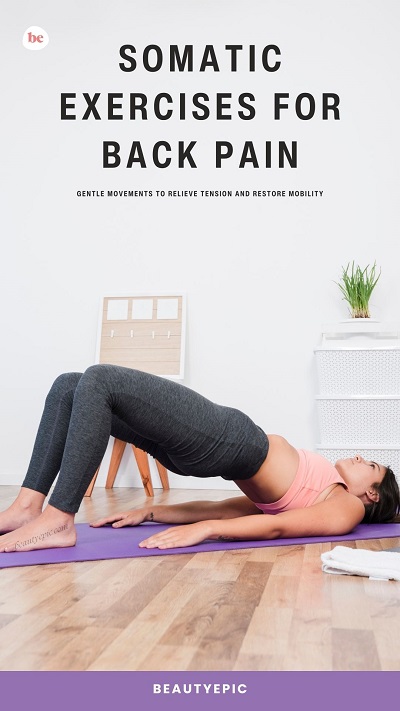
Important: This article is for informational purposes only. Please read our full disclaimer for more details.
Back pain is one of the most common health issues worldwide, affecting millions of people across all ages. Whether caused by poor posture, muscle tension, injury, or stress, back discomfort can disrupt your daily life and overall well-being. While painkillers and physical therapy are common solutions, an increasing number of experts are turning to somatic exercises — a gentle, mindful movement practice — to release tension, retrain the nervous system, and restore natural body alignment.
In this guide, we’ll explore what somatic exercises are, how they help with back pain, and what science says about their effectiveness.
What Are Somatic Exercises and How Do They Help Back Pain?
Somatic exercises are slow, mindful movements designed to retrain your brain and muscles to release chronic tension. Unlike traditional stretching or strength training, somatic exercises focus on neuromuscular re-education — teaching your nervous system how to “reset” muscle patterns caused by stress, repetitive habits, or trauma.
Back pain often stems from sensory motor amnesia — a condition described by Dr. Thomas Hanna, founder of the somatic movement approach. This occurs when your brain “forgets” how to properly control certain muscles, leading to stiffness, misalignment, and discomfort. Somatic exercises help by:
- Reconnecting the brain and body to restore natural movement patterns
- Releasing unconscious muscle contractions that contribute to back pain
- Improving posture by balancing tension across the spine and core
- Enhancing flexibility and mobility without forceful stretching
Science Benefits of Somatic Exercises for Back Pain
Several studies highlight the effectiveness of somatic-based movement therapies for managing chronic back pain:
- A study in the Journal of Bodywork and Movement Therapies (2020) found that gentle somatic movement practices significantly reduced lower back pain and improved functional mobility among participants (1).
- Research from the International Journal of Yoga Therapy revealed that mindful movement techniques like somatics reduce muscle guarding and enhance body awareness, leading to better posture and pain relief (2).
- Neuroscientists emphasize that slow, intentional movements can “rewire” the brain’s motor patterns, helping reverse long-standing muscular tension.
Unlike quick fixes, somatic exercises address the root cause of back pain by calming the nervous system and retraining muscle memory.
6 Somatic Exercises for Back Pain Relief
Somatic exercises are gentle, mindful movements that help release chronic muscle tension and restore natural mobility. Below are six highly effective somatic exercises specifically designed to relieve back pain, improve posture, and enhance flexibility.
1. Arch and Flatten (Lower Back Release)
Purpose: Loosens tight lower back muscles and improves lumbar flexibility.
How to Do It
- Lie on your back with knees bent and feet flat on the floor, hip-width apart.
- Place your hands gently on your stomach.
- Inhale deeply and slowly arch your lower back, creating a small space between your back and the floor.
- Exhale slowly and gently flatten your lower back into the mat.
- Move slowly and mindfully, paying attention to sensations in your lower spine.
Repetitions: 8–10 times
Pro Tip: Imagine your pelvis rocking like a gentle seesaw — there’s no need to force the movement.
2. Pelvic Tilts (Releasing Hip and Back Tension)
Purpose: Relaxes the lower back, pelvis, and hip flexors — areas that often hold hidden tension.
How to Do It
- Lie on your back with knees bent and feet on the floor.
- Place your hands on your lower abdomen.
- Inhale and tilt your pelvis forward, slightly lifting your lower back.
- Exhale and tilt your pelvis backward, gently pressing your lower back into the floor.
- Keep your shoulders, neck, and arms relaxed throughout.
Repetitions: 10–12 times
Pro Tip: Move slowly and deliberately — somatics is about mindful control, not speed.
3. Side-Bending Reach (Spinal Flexibility Booster)
Purpose: Releases stiffness along the spine and improves the flexibility of the oblique muscles and intercostals.
How to Do It
- Sit comfortably or stand tall with feet hip-width apart.
- Inhale and raise your right arm overhead.
- Exhale and gently bend your torso to the left, reaching your hand over your head.
- Hold for 3–5 seconds, breathing naturally.
- Return slowly to the center and repeat on the other side.
Repetitions: 5–6 times per side
Pro Tip: Imagine lengthening your spine rather than collapsing into the side bend.
4. Cat-Cow Somatic Flow (Spinal Mobility Reset)
Purpose: Combines gentle flexion and extension to release back tension and improve overall spinal mobility.
How to Do It
- Start on your hands and knees in a tabletop position.
- Inhale and gently arch your back, lifting your tailbone and chest — Cow Pose.
- Exhale and slowly round your spine, tucking your chin and pelvis — Cat Pose.
- Move slowly and consciously, syncing breath with movement.
Repetitions: 8–10 cycles
Pro Tip: Focus on feeling each vertebra move one at a time for maximum benefit.
5. Somatic Bridge Roll (Releasing Lower Back Tightness)
Purpose: Strengthens core stability while releasing deep-seated tension in the lower back.
How to Do It
- Lie on your back with knees bent and feet hip-width apart.
- Place your arms alongside your body with palms facing down.
- Inhale and slowly lift your pelvis off the floor, vertebra by vertebra.
- Pause at the top, breathing naturally.
- Exhale and gently roll your spine back down, one vertebra at a time.
Repetitions: 6–8 times
Pro Tip: Imagine your spine melting into the mat as you lower down — this enhances the somatic release effect.
6. Knee-to-Chest Rock (Lower Back Decompression)
Purpose: Relieves compression in the lumbar spine and relaxes tight lower back muscles.
How to Do It
- Lie flat on your back and draw both knees toward your chest.
- Wrap your arms around your shins.
- Gently rock side-to-side in a slow, controlled motion.
- Keep your shoulders and neck relaxed.
Duration: Rock gently for 30–60 seconds
Pro Tip: Synchronize your breath with the rocking for deep relaxation.
How to Get the Most Out of These Somatic Exercises
- Move slowly: The slower you move, the more effectively you retrain your nervous system.
- Stay mindful: Focus on the sensations in your body rather than forcing a stretch.
- Breathe deeply: Deep breathing helps release stored tension and promotes relaxation.
- Be consistent: Practicing 10–20 minutes daily offers the best long-term results.
Frequently Asked Questions (FAQ’S)
1. How long does it take to see results from somatic exercises?
A. Many people notice improvements in muscle relaxation and mobility after just a few sessions. For chronic back pain, 4–6 weeks of consistent practice often shows significant results.
2. Can I do somatic exercises if I have a herniated disc or severe back injury?
A. Yes, but it’s best to consult a physical therapist or somatic practitioner to modify movements for your condition. Somatic exercises are generally low-impact and safe, but professional guidance ensures proper technique.
3. How often should I practice somatic exercises?
A. For optimal results, aim for 10–20 minutes daily or at least 3–4 times per week. Consistency helps retrain your nervous system effectively.
Somatic exercises offer a gentle yet powerful solution for back pain by addressing the root causes of muscular tension and poor movement patterns. Instead of forceful stretching or aggressive workouts, these mindful movements retrain your nervous system to release tight muscles and restore natural posture.
















